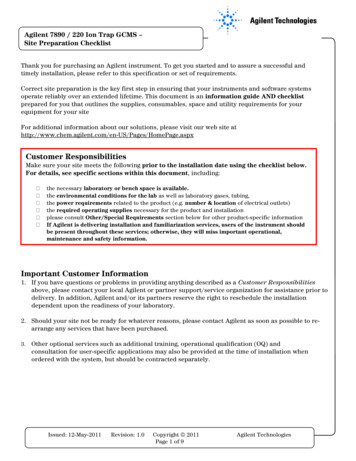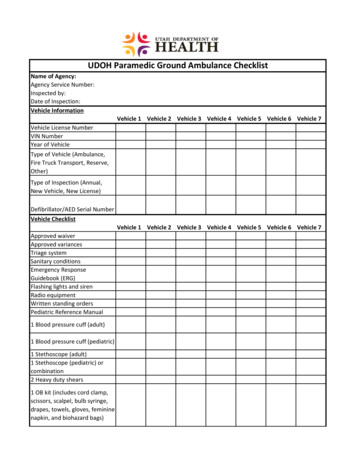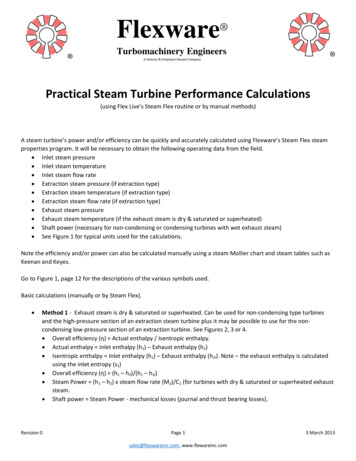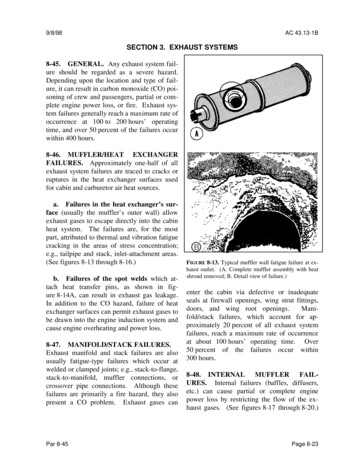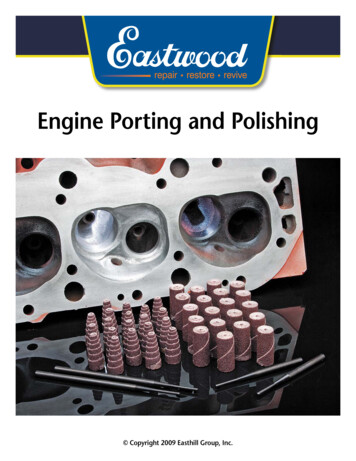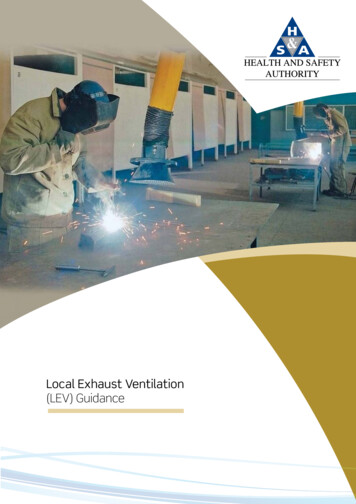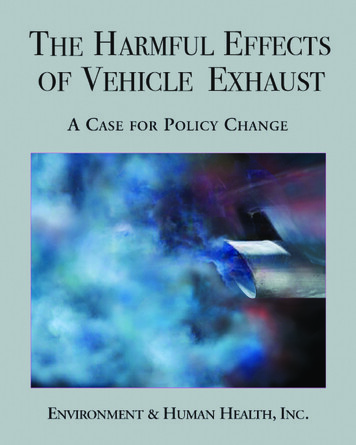
Transcription
The Harmful Effects of Vehicle ExhaustTHE HARMFULEFFECTS OFVEHICLE EXHAUSTA CASEFORPOLICY CHANGEResearch and publication of this report was made possible bythe Tortuga Foundation, the Alida R. MessingerCharitable Lead Trust, No. 2, and theStewart and Constance Greenfield Foundation.Environment & Human Health, Inc.1191 Ridge Road North Haven, CT 06473Phone: (203) 248-6582 Fax: (203) 288-7571www.ehhi.org1
The Harmful Effects of Vehicle ExhaustENVIRONMENT AND HUMAN HEALTH, INC.MISSION STATEMENTEnvironment and Human Health, Inc., founded in 1997, is a nonprofit organization made up of doctors, public health professionals andpolicy experts dedicated to the purpose of protecting public health fromenvironmental harms through research, education and the promotionof sound public policy. We are committed to improving public healthand to the reduction of environmental health risks to individuals.Our mission is:(1.) To conduct research to identify environmental harmsaffecting human populations.(2.) To promote public education concerning the relationshipsbetween the environment and human health.(3.) To promote effective communication of environmentalhealth risks to those exposed and to responsible publicand private officials, thereby empowering individualsand groups to take control over the quality of theirenvironment and be more protective of themselves andtheir families.(4.) To promote policies in all sectors that ensure the protectionof human and environmental health with fairness andtimeliness. Environment and Human Health, Inc. has puthuman health at the center of its environmental agenda.2
The Harmful Effects of Vehicle ExhaustTHE HARMFUL EFFECTSOF VEHICLE EXHAUSTA CASEFORPOLICY CHANGEJohn Wargo, Ph.D.Yale UniversityLinda Wargo, MESNancy Alderman, MESPresident, Environment and Human Health, Inc.CONTRIBUTOR TO PROJECTDavid R. Brown, Sc.D.Public Health Toxicologist, EHHITHIS PROJECT WAS DEVELOPED AND MANAGED BYENVIRONMENT AND HUMAN HEALTH, INC.EDITING AND GRAPHIC DESIGN BYJane Bradley, MALS, Medical/Science WriterCopyright 2006 Environment & Human Health, Inc.Printed on recycled paper with soy-based inks3
The Harmful Effects of Vehicle ExhaustTable of ContentsOVERVIEW.6SUMMARY OF FINDINGS .81. AIR POLLUTION, VEHICLE EXHAUST, AND HUMAN HEALTH .14Asthma.14Chronic Obstructive Pulmonary Disease.16Heart Disease.16Cancer.18Diabetes .18Susceptible Populations in Connecticut .192. VEHICLE EMISSIONS, FEDERAL REGULATIONS AND HEALTH .21CRITERIA POLLUTANTS OF CONCERN: OZONE AND PARTICULATE MATTER.23Ozone.23Particulate Matter .27PM Levels in Connecticut.28HAZARDOUS AIR POLLUTANTS (HAPS).31Hazardous Air Pollutants of Concern in Connecticut .31NATIONAL AMBIENT AIR QUALITY STANDARDS (NAAQS).34Problems with Averaging Pollution Levels .353. VEHICLE TRANSPORTATION TRENDS .36Vehicle Miles Traveled by Vehicle Type .37Trends in Fuel Economy.37Trends in Fuel Consumption .384. MONITORING VEHICLE EMISSIONS .40Averaging Air Pollution .40Air Quality Monitoring Deficiencies .40Photochemical Assessment Modeling (PAM).40Monitoring Systems for Vehicle Exhaust in Connecticut .415. IDLING INITIATIVES .42Canada .42Japan .42United States .434
The Harmful Effects of Vehicle Exhaust6. CONNECTICUT’S LEGISLATIVE EFFORTSTO IMPROVEVEHICLE-RELATED AIR QUALITY .44Mobile Source Idling .44School Bus Idling.44Diesel Emissions .45Vehicle Greenhouse Gas Emissions .457. GREENHOUSE GASES (GHGS) AND GLOBAL WARMING .468. RECOMMENDATIONS .48Recommendations for the Federal Government.48Recommendations for the State Government .49Recommendations for Local Governments .50Recommendations for Individuals.51LIST OF TABLESTABLE 1: Connecticut Populations at Elevated Risk.19TABLE 2: List of Mobile Source Air Toxics within HAPs .31TABLE 3: Air Toxics of Greatest Concern in Connecticut.33TABLE 4: National Ambient Air Quality Standards.35TABLE 5: Rising Rates of Transportation Fuel Consumption in New England Since 2001.39LIST OF FIGURESFIGURE 1: Connecticut and U.S. Populations Susceptible to Harmful Effects from Air Pollution.20FIGURE 2: Estimated Median Cancer Risk by County, 1996, All Carcinogens .22FIGURE 3: Hourly Ozone Levels, 2004, East Hartford, Connecticut.24FIGURE 4: Hourly Ozone Levels at Connecticut Monitoring Sites.25FIGURE 5: Connecticut High Pollution Episode, July 20-24, 2004 .26FIGURE 6: Connecticut PM2.5 Jan. 1–July 1, 2005 .29FIGURE 7: Connecticut PM2.5 Jan. 1–July 1, 2005 .29FIGURE 8: Particulate Matter 2.5 Microns and Smaller .30FIGURE 9: 1999 HAPs Emissions by County.32FIGURE 10: Changes in VMT by Vehicle Type .37FIGURE 11: Fuel Economy Averages: New Passenger Cars and Light Trucks .37FIGURE 12: Trends in Diesel Fuel Consumption in the U.S .38FIGURE 13: U.S. Motor Vehicle Fuel Economy .39FIGURE 14: Pollutant Monitoring Stations .41FIGURE 15: Carbon Dioxide Emissions in Connecticut .475
The Harmful Effects of Vehicle ExhaustOverviewOverviewMost people assume that the U.S. Environmental Protection Agency issufficiently protecting air quality by setting limits for chemicals releasedfrom vehicles, requiring newer engines to be less polluting, and restrictinglevels normally found in outdoor air. It is clear, however, thatthese efforts are not enough to protect health, as they limit onlya small percentage of all chemicals that are emitted fromengines, leaving hundreds of pollutants unmonitored andunregulated. While the government monitors pollutants at fixedstations, these measurements bear little resemblance to thepollution you and your family experience while moving throughdaily life. EPA also requires that measured concentrations ofregulated pollutants be averaged over long periods of time todetermine compliance with standards. Particulate matter, forexample, is averaged over three years, and this practice maskshigh-pollution episodes of short duration that can damage health.Although we havegrown to acceptthe smell of engineexhaust as a partof everyday life,our nation isexperiencing anepidemic ofillnesses madeworse by airpollution.Although we have grown to accept the smell of engine exhaustas a part of everyday life, our nation is experiencing an epidemicof illnesses made worse by air pollution. Over the past ten years,hundreds of studies have been published in the peer-reviewed literaturedemonstrating special vulnerability to air pollution among those withserious illnesses, including asthma, chronic obstructive pulmonary disease(COPD), cardiovascular disease, diabetes, and lung cancer. Tens of millionsof Americans suffer from these illnesses. Children, the elderly, those withcompromised immune systems, and those with specific genetic traits are atspecial risk. We estimate that hundreds of thousands of Connecticut’sresidents are at heightened risk due to these background illnesses. Duringthe past decade, scientists have also confirmed a relationship between twoforms of pollution—ozone and particulate matter—and increased rates ofmortality, especially among those with cardiovascular disease. These studiesare reviewed and summarized in the report that follows.Connecticut’s air quality is exceptionally poor. Polluted air flows into thestate from densely populated areas in the Northeast Corridor and theMidwest. In addition, Connecticut residents now drive 31 billion miles in6
The Harmful Effects of Vehicle Exhaustthree million vehicles each year. Vehicle use is the largest contributor to thestate’s air pollution problem, although power plant emissions, heating fuelcombustion, and industrial wastes also contribute to our pollution burden.Several billion gallons of fuel are burned in the state each year, and theamount consumed is increasing. Heavy truck traffic is also increasing, andolder diesel engines are especially polluting. Diesel engines have exceptionally long life spans—often several millions of miles for long distancetrucks—and engines are commonly rebuilt. This means that we cannotrely on improvements in new engine design to solve the problem, since thecurrent fleet will remain on the road for a decade or more. Fuels burned inthe state release hazardous pollutants each year into the air in closeproximity to residential, occupational, educational and recreational facilities.The dirtiest part of the day for many children is the bus ride to and fromschool as they sit in a string of cars and buses, often in rush hour traffic. Theproblem is especially severe where major highways intersect with urbancenters such as New Haven, Hartford, Bridgeport and Stamford.Connecticut’s air pollution levels violate the federal Clean Air Act standardsfor both particulate matter and ozone. Both forms of pollution are producedfrom fuel combustion, and even the current limits are not sufficient toprotect human health. The particulate problem is most severe in thesouthwestern part of the state, due to population density, traffic intensity,and proximity to the New York metropolitan area. New engine designs toreduce emissions have been overwhelmed by the increasing numbers ofvehicles, and the increasing miles traveled per vehicle per year. Connecticutis also the nation’s fourth-highest consumer of home heating oil, which isnearly identical to diesel fuel used for transport. More heating oil isconsumed per square mile in Connecticut than in any other state.Most of Connecticut’s growth during the past 50 years has occurred insuburban and rural regions, increasing the population’s dependence on personal vehicles. More than three million vehicles are registered in a state withonly 3.5 million residents. Many people assume that their individual contributions are insignificant, yet the collective effect is damaging to health. Thecosts of medical care for pollution-aggravated illness fall disproportionatelyon the poor, since they are less likely to be under the routine care of aphysician to prevent severe attacks that often require hospitalization.7OverviewNew enginedesigns to reduceemissions havebeen overwhelmedby the increasingnumbers ofvehicles, and theincreasing milestraveled pervehicle per year.
The Harmful Effects of Vehicle ExhaustSummary of FindingsSummary of FindingsnnAir Pollution and Human HealthScientific experts now believe the nation faces an epidemic of illnessesthat are exacerbated by air pollution. These illnesses include cardiovascular disease, asthma, chronic obstructive pulmonary disease, lungcancer, and diabetes.Children at Special RiskThe American Academy of Pediatrics has concluded that levels of ozoneand particulate matter are high enough in many parts of the U.S. tothreaten children’s health.1 Eleven million U.S. children live in areas thatexceed one or more federal air quality standards; 9 million children live inareas where ozone standards are exceeded; 3.5 million children live in areaswhere the particulate standards are exceeded, and 2.8 million childrenlive in counties where the carbon monoxide standard is exceeded.2The AmericanAcademy ofPediatrics hasconcluded thatlevels of ozoneand particulatematter are highenough in manyparts of theU.S. to threatenchildren’s health.1nElderly at Special RiskCardiovascular disease, hypertension, diabetes and cancer are all illnesses disproportionately borne by the elderly. Nearly one-half millionConnecticut residents are over 65 years of age.nAsthmaChemicals in vehicle exhaust are harmful to asthmatics. Exhaust canadversely affect lung function 3, 4, 5, 6 and may promote allergic reactionsand airway constriction.7 All vehicles, especially diesel engines, emit veryfine particles that deeply penetrate lungs and inflame the circulatorysystem, damaging cells and causing respiratory problems.8 Even shortterm exposure to vehicle exhaust may harm asthmatics.9,10,11,12 Asthmaticchildren are particularly sensitive to air pollution. New England stateshave some of the highest asthma rates in the country. About 9 percent ofConnecticut’s youth have the disease.13 Inhalation of vehicle emissions,even for short periods, may be harmful to asthmatics. One study foundthat children are 40 percent more likely to have an attack on high outdoorpollution days. 14nChronic Obstructive Pulmonary DiseaseVehicle emissions are particularly harmful to people afflicted withchronic obstructive pulmonary disease (COPD), such as chronicbronchitis. Significant and replicated associations have been found8
The Harmful Effects of Vehicle Exhaustbetween increased ozone levels and a range of adverse effects on thelungs,15 and several studies have shown increased risk of hospitaladmission from COPD associated with high ozone levels.16 There isalso a relationship between the levels of PM10 and morbidity 17 inpatients with COPD. These associations were noted in Philadelphia,where the major source of these particles is motor vehicles.18 Fineparticle matter is especially harmful to people with COPD 19, 20 and hasbeen found to increase their hospital admission rates. 21 High levels ofPM10 are also associated with increased morbidity among those with theillness.nCardiovascular DiseaseMortality and hospital admissions for myocardial infarction, congestivecardiac failure and cardiac arrhythmia increase with a rise in theconcentrations of particulate and gaseous pollutants.22 Asconcentrations of airborne particles increase, those with cardiovasculardisease may experience increasing severity of symptoms, rates ofhospitalization, and mortality.23 The risk of having a heart attack isgreater for people exposed to pollution from heavy traffic, as well as forthose living near air-polluted roadways.24nCancerVehicles emit numerous carcinogenic chemicals. Diesel containsbenzene, formaldehyde, and 1,3-butadiene—all three are wellrecognized carcinogens. EPA estimates that vehicle emissions accountfor as many as half of all cancers attributed to outdoor air pollution.25nDiabetesIncreasing levels of air pollution are associated with rising mortalityrates among diabetics. Because of the overlap between diabetes andcardiovascular disease, the nature of this association is not yet clear. 26nSummary of FindingsAir Pollution Increases Mortality Among Susceptible GroupsAir pollution kills more Americans than breast and prostate cancerscombined,27 and the premature deaths associated with particulatematter pollution alone are comparable to deaths from traffic accidents. 28Air pollution is a serious and growing threat to the health of Connecticutresidents. We estimate that nearly one million of Connecticut’s 3.5million residents experience one or more of these illnesses, some withoutknowing it.9As concentrationsof airborneparticles increase,those with cardiovascular diseasemay experienceincreasing severityof symptoms, ratesof hospitalization,and mortality. 23
The Harmful Effects of Vehicle ExhaustnSummary of FindingsVehicle EmissionsMobile emissions that are believed to present the greatest health risk toConnecticut residents include ozone, particulate matter, acetaldehyde,acrolein, benzene, 1,3-butadiene, formaldehyde, and diesel exhaust.nOzone and Motor VehiclesMotor vehicles emit millions of pounds of hazardous pollutants into theair each year in the U.S., including volatile organic compounds andoxides of nitrogen (NOx). These chemicals form ozone in the presenceof sunlight.nDiesel exhaustis especiallydangerous,containing nearly40 hazardouspollutants.Diesel emissionsincrease theseverity andduration ofasthma attacks.Fine Particulate MatterFine particulate matter is a serious threat to human health. Fineparticles can aggravate both heart and lung diseases. Those withdiabetes, older adults, and children are especially sensitive. Fineparticulate matter is responsible for several tens of thousands ofpremature deaths annually in the U.S.29 and is measured at levelsabove federal air quality standards in Connecticut. 30nDiesel ExhaustDiesel exhaust is especially dangerous, containing nearly 40 hazardouspollutants. The mixture contains carbon particles that are exceptionallysmall in size, less than one micron. These fine particles may be deeplyinhaled into the lung and carry with them a collection of attachedhazardous compounds. Diesel emissions increase the severity andduration of asthma attacks.nDiesel EmissionsThe California Air Resources Board concluded that diesel emissionsaccount for the majority of cancer risk created by all outdoor airpollution sources in the state. The American Academy of Pediatricsrecommends that children’s exposure to diesel exhaust particles shouldbe decreased and that idling of diesel vehicles in places where childrenlive and congregate should be minimized to protect their health.31School bus particulate emissions sometimes exceed the federal PM2.5standards by as much as ten-fold.10
The Harmful Effects of Vehicle ExhaustnAveraging Air PollutionThe government is allowed to average some pollutants across longperiods of time. For example, PM2.5 is permitted to be averagedover 24 hour intervals, and the 24-hour averages are then averagedover three years, before compliance with federal standards isdetermined. The results mask serious high pollution episodes.Medical scientists have determined that much shorter-termexposures, measured in hours or minutes, are potentially dangerousto susceptible populations, such as those with cardiovascular,respiratory, and other illnesses.nnAir Quality Monitoring DeficienciesGovernment understanding of the severity of air pollution dependsupon what is being monitored and where the monitoring occurs.Air quality varies across space and time, and is dependent uponclimatic conditions. It is poorest, but may not be monitored, wheretraffic is most intense, normally where highways slow near urbanareas, near construction sites, and where trucks, buses, and carstend to concentrate and idle: schools, hospitals, shopping centers,truck stops, warehouses, ports and shipping facilities, oil tankfarms, rail stations, bus terminals, and where gas and diesel poweredvehicles are used within warehouses or ships.Diesel Fuel ConsumptionUse of diesel fuel doubled in the U.S. between 1982 and 1998. Thedemand for transportation fuel continues to rise throughout thenation, particularly for diesel fuel.nFuel Economy StagnationIn the last 15 years, there has been little improvement in the milesper gallon (MPG) rating of cars and light trucks. The average MPGachieved by trucks has remained the same for the last 30 years atapproximately 5.5 miles per gallon.nHighways as Air Pollution CorridorsHighways are recognized by scientific experts to act as threedimensional corridors of air pollution containing many hazardouschemicals.11Summary of FindingsUse of diesel fueldoubled in theU.S. between1982 and 1998.The demand fortransportationfuel continues torise throughoutthe nation,particularly fordiesel fuel.
The Harmful Effects of Vehicle ExhaustnSummary of FindingsnThe increase inthe vehicle milestraveled inrecent years hasoverwhelmed thetechnologicaladvances madewith respect tovehicle emissionsreductions.41nnnnFuel Oil ConsumptionHome heating fuel is essentially the same as diesel fuel, although thesulfur content is higher. Connecticut is exceptionally dependent onNo. 2 fuel oil for heating purposes, and last year ranked fourth in thenation in raw consumption at more than 660 million gallons. Bycontrast, 230 million gallons of diesel fuel were used for transportpurposes. Connecticut ranks first in the nation in fuel oil consumptionper square mile of state area. This means that diesel pollution will bemost severe where residential and traffic density are highest. It alsoexplains the high particulate counts routinely measured in areas wherepopulation density is high and where multiple traffic lanes funnel intosingle lanes. Chronic traffic congestion leads to chronic humanexposure to known hazardous air pollutants.PM2.5 Non-ComplianceFine particulate matter in Connecticut exceeds federal air qualitystandards.32 During the first six months of 2005, levels of fineparticulates, or PM2.5, in New Haven, Connecticut, exceeded thefederal standard for 70 days, roughly 40 percent of the time.Ozone Non-ComplianceThe entire state of Connecticut exceeds the eight-hour ozonestandard.33Connecticut’s Dependence on Motor VehiclesFewer than three percent of Connecticut residents walk to work ,34 and45 percent of all Connecticut trips under a half-mile are made in avehicle.35 Connecticut residents spend on average 70 minutes a day intheir cars, often breathing this polluted air. 36Connecticut Citizens’ Proximity to HighwaysOne in three Connecticut citizens live within a mile of an interstatehighway. As many as 70,000 of those residents are under the age offive.37 In addition, 37 percent of the state’s schools are located within amile of an interstate highway. 38Vehicle Miles Traveled (VMT)Connecticut residents own nearly three million vehicles, and travelnearly 31 billion miles each year. Each year residents put more miles ontheir vehicles in a year than ever before. The number of vehicles driven in12
The Harmful Effects of Vehicle Exhaustthe state is also growing. Between 1995 and and 2000, state residentsincreased the miles driven by 10 percent 39 and this trend is expected tocontinue. The number of Vehicle miles traveled (VMT) in the state isprojected to rise by another 12 percent by 2010 and by 27 percent by2025.40 The increase in VMT in recent years has overwhelmed the technological advances made with respect to vehicle emissions reductions. 41nnnIdling and Wasted FuelThe U.S. Argonne National Laboratory estimates that about 20 millionbarrels of diesel fuel are consumed each year by idling long-haul trucks.Estimated truck emissions total about 10 million tons of CO2, 50,000tons of nitrogen oxides, and 2,000 tons of particulates.42Natural Resources Canada estimates that idling a light duty vehicle for10 minutes a day uses an average of 26.4 gallons (100 liters) of gas a year.Assuming Connecticut has approximately 2.2 million light duty vehicles,if idling time were reduced by 10 minutes per day for each, nearly 58million gallons of gas would be saved per year, along with 145 million infuel costs per year if one assumes that gas costs 2.50 per gallon.Vehicle Emissions and Climate ChangeVehicle emissions contribute to air pollution generated from thecombustion of fossil fuels from many other sources, including theburning of coal and oil in power plants, incinerators, home heating oil,and construction equipment. The combustion of gas and diesel fuelsproduce greenhouse gases that are contributing to local, regional andglobal climatic changes. A recent study published in Science analyzedmore than 900 scientific articles listed with the keywords “global climatechange.” Not one disagreed with the consensus view that humans arecontributing to global warming.43 Little initiative is expected on this issueat the national and international levels of government. Connecticut hasthe potential to become a leader among states in reducing these gases.nSummary of FindingsCarbon DioxideCarbon dioxide (CO2), considered the largest contributor to greenhouseclimate change, accounts for more than 80 percent of U.S. greenhousegas emissions. One-third of these emissions come from thetransportation sector.44 Carbon dioxide emissions originate almostentirely from fossil fuel consumption, and two-thirds of U.S. fuelconsumption is used for transportation. 4513Carbon dioxideemissionsoriginate almostentirely fromfossil fuelconsumption,and two-thirdsof U.S. fuelconsumptionis used fortransportation. 45
1. 1. Human HealthWe estimatethat hundredsof thousands ofConnecticut’sresidents are atheightened riskfrom airpollutionbecause of theirbackground ofchronic illness. The Harmful Effects of Vehicle ExhaustAir Pollution, VehicleExhaust, and Human HealthOver the past 10 years, hundreds of studies have been published in the peerreviewed literature demonstrating the special vulnerability to air pollutionthat exists among susceptible populations with serious illnesses. Tens ofmillions of Americans suffer from these illnesses, which include asthma,chronic obstructive pulmonary disease (COPD), cardiovascular diseases,diabetes, and lung cancer. Also at special risk are children, the elderly, thosewith compromised immune systems, and those with specific genetic traits.During the past decade, scientists have confirmed a relationship between twoforms of air pollution, ozone and particulate matter, and increased rates ofmortality, especially among those with cardiovascular disease. We estimatethat hundreds of thousands of Connecticut’s residents are at heightened risk ofhealth loss from air pollution because of their background of chronic illness.AsthmannnAsthma has reached epidemic proportions in the U.S.46 and is the mostprevalent chronic disease among U.S. children.47 The CDC NationalCenter for Health Statistics estimates
1191 Ridge Road North Haven, CT 06473 Phone: (203) 248-6582 Fax: (203) 288-7571 www.ehhi.org Research and publication of this report was made possible by the Tortuga Foundation, the Alida R. Messinger Charitable Lead Trust, No. 2, and the Stewart and Constance Greenfield Foundation. THE HARMFUL EFFECTS OF VEHICLE EXHAUST A CASE FOR .


